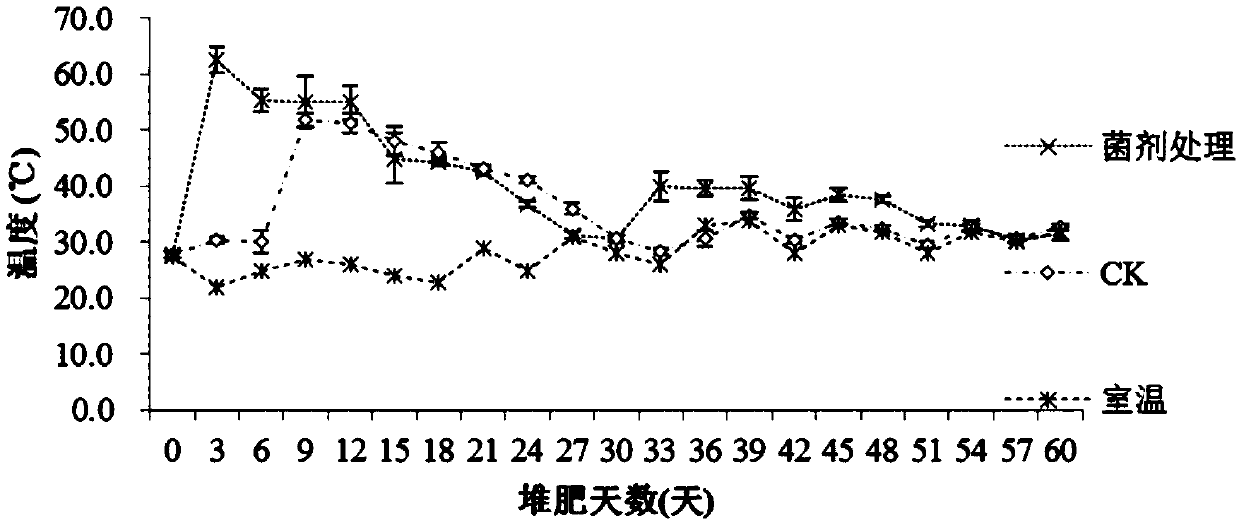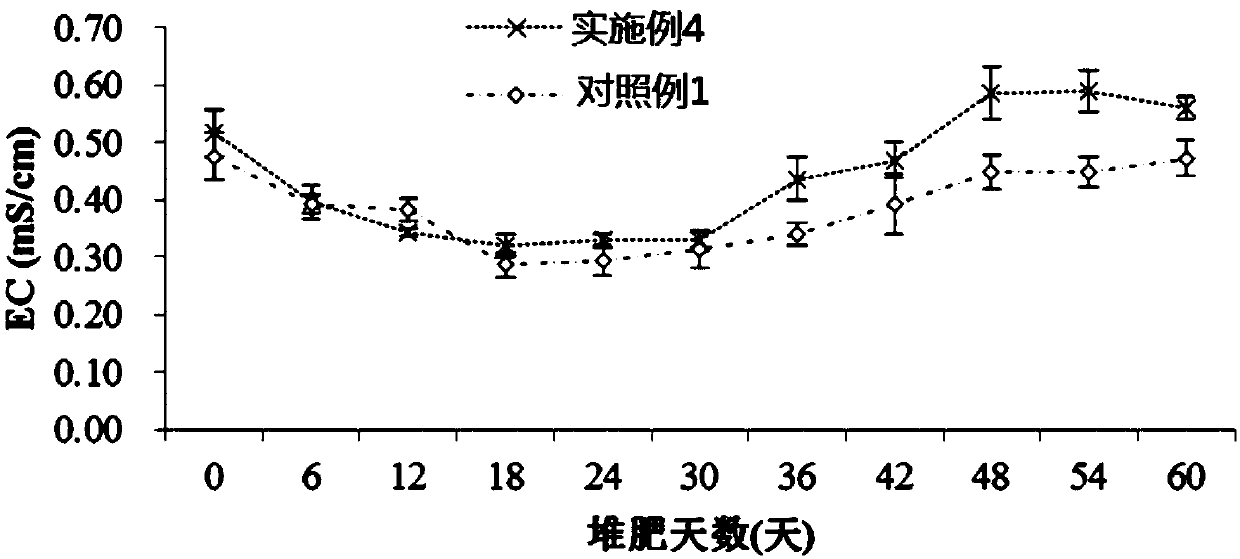Compound microbial inoculum used for waste composting, preparation method of compound microbial inoculum, and waste composting method
A technology of compound bacterial agent and waste, applied in biochemical equipment and methods, preparation of organic fertilizers, methods based on microorganisms, etc., can solve the problems of inability to produce and limit the decomposition effect, and achieve less usage and significant lignin and the effect of cellulolytic function
- Summary
- Abstract
- Description
- Claims
- Application Information
AI Technical Summary
Problems solved by technology
Method used
Image
Examples
Embodiment 1
[0058] The screening of embodiment 1 composite bacterial agent microorganism
[0059] The composting experiment at this stage is to screen microorganisms in the decomposing stage. The experiment was carried out at the composting plant of Beijing Botanical Garden.
[0060] 1.1 Composting
[0061] The raw materials are mainly branches and leaves of summer common tree species from Beijing Botanical Garden (including but not limited to ash, poplar, willow, pagoda tree, black locust tree). Branches and leaves are crushed into fragments with a particle size of about 20 mm, which are evenly spread on the ground. The compost materials used in the experiment are collected from the fragments, and then piled up into a conical pile of 1 cubic meter (the base area is 3 square meters, and the height is 1 meter).
[0062] Sub-samples were taken from the top, middle, and bottom of the pile and mixed into one composite sample for chemical analysis (TOC, total carbon: 47.8%, TN (total nitrog...
Embodiment 2
[0081] Embodiment 2 The multiplication and cultivation of 3 bacterial strains
[0082] 1) Propagation and cultivation of Bacillus subtilis and Bacillus thuringiensis
[0083] Inoculate the screened bacteria B1 and B2 into beef extract peptone liquid medium (peptone 10g, beef extract 3g, NaCl 5g, water 1L, pH: natural, high temperature sterilization at 121°C for 30min), the inoculation amount is volume ratio 0.1% (that is, 1ml of bacterial culture solution in a 1L Erlenmeyer flask), cultured for 72h (usually 60-80h) at a culture temperature of (28±2)°C (usually 20-35°C) and a rotation speed of 180rpm; The cultured liquid strain is inoculated into a 5L fermenter equipped with beef extract peptone liquid medium with a volume ratio of 5% inoculum, ventilated culture, culture temperature (28 ± 2) ° C (usually 20-35 ° C ), the stirring speed is 45rpm, the ventilation volume is 1m 3 / L, culture time 28h (usually 20-35h), obtain B1 bacterium liquid, B2 bacterium liquid respectively;...
Embodiment 3
[0087] Example 3 3 bacterial strain dosage screening
[0088] 1) Prepare the compound bacterial agent according to the quadratic regression orthogonal design
[0089] As shown in Tables 1 and 2, according to the code value table and the experimental design table of the quadratic regression orthogonal test, determine the proportioning additions of the three bacterial solutions in each experimental group, and the proportioning additions of the bacterial solutions are shown in Table 3.
[0090] According to the design scheme as shown in Table 1, a quadratic orthogonal regression experiment was carried out to determine the ratio and dosage of the three strains of microorganisms in the composite bacterial agent.
[0091] Table 1 The code value and corresponding addition amount of each diluted bacterial solution
[0092]
[0093] Table 2 quadratic regression orthogonal design table
[0094]
[0095] According to table 1, table 2, the volume consumption of 3 kinds of microbia...
PUM
| Property | Measurement | Unit |
|---|---|---|
| Particle size | aaaaa | aaaaa |
Abstract
Description
Claims
Application Information
 Login to View More
Login to View More - R&D
- Intellectual Property
- Life Sciences
- Materials
- Tech Scout
- Unparalleled Data Quality
- Higher Quality Content
- 60% Fewer Hallucinations
Browse by: Latest US Patents, China's latest patents, Technical Efficacy Thesaurus, Application Domain, Technology Topic, Popular Technical Reports.
© 2025 PatSnap. All rights reserved.Legal|Privacy policy|Modern Slavery Act Transparency Statement|Sitemap|About US| Contact US: help@patsnap.com



